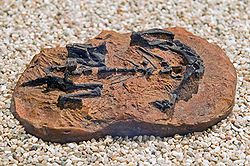Mussaurus
| Mussaurus Temporal range: Upper Triassic
| |
|---|---|

| |
| Fossil juvenile skeleton | |
| Scientific classification | |
| Kingdom: | |
| Phylum: | |
| Class: | |
| Superorder: | |
| Order: | |
| Suborder: | |
| Infraorder: | |
| Genus: | Mussaurus
|

Mussaurus (meaning "mouse lizard") was an early, plant-eating prosauropod dinosaur from the Upper Triassic, about 215 million years ago. It was found in southern Argentina. It gets its name from the small size of the skeletons first discovered. They were large-eyed hatchlings (babies), only 9-16 inches long (18-37 cm); these are the smallest dinosaur skeletons yet found.
However, Mussaurus is now known from adult specimens.[1] the name is something of a misnomer; adults possibly reached 3 m (10 ft) in length, and weighed 70 kilograms (150 lb).[2] Mussaurus possesses anatomical features suggesting a close, possibly transitional evolutionary relationship with true sauropods.
References[change | change source]
- ↑ Otero A. & Pol D. 2013. Postcranial anatomy and phylogenetic relationships of Mussaurus patagonicus (Dinosauria, Sauropodomorpha). Journal of Vertebrate Paleontology 33 (5): 1138. [1]
- ↑ Montague, Jeremy R. 2006. Estimates of body size and geological time of origin for 612 dinosaur genera (Saurischia, Ornithischia). Florida Scientist, 69(4): 243-257.
